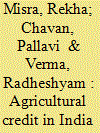| Srl | Item |
| 1 |
ID:
144515


|
|
|
|
|
| Summary/Abstract |
The period of the 2000s witnessed a sharp revival in agricultural credit in India that was largely policy induced. There were emerging shifts in institutional, functional and regional distributions of agricultural credit during the decade. This study attempts to explore the relationship between agricultural credit and agricultural production/productivity. The state-level panel model attempted in this article suggests a positive impact of the intensity of agricultural credit on total factor productivity in agriculture. The impact was relatively stronger with respect to direct agricultural credit. A case study of the (combined) state of Andhra Pradesh also suggests a positive association between agricultural credit and agricultural production. The study lends credence to the policy approach of including agriculture, the largest employer in the Indian economy, as a sector for priority credit in India. It also highlights the point that the sector deserves continued policy support in order to move onto a sustainable and higher growth path.
|
|
|
|
|
|
|
|
|
|
|
|
|
|
|
|
| 2 |
ID:
183486


|
|
|
|
|
| Summary/Abstract |
The agriculture sector in India is marred with several problems, which have resulted in farmers’ distress. To address the distress of the farmers, both Central and State Governments of India implemented agricultural debt waiver schemes (ADWRSs) as major policy interventions in recent years. These schemes differ in terms of coverage of the farmers and lending agencies. However, all of them aim to benefit millions of small and marginal farmers of India. The implication and evaluation of these schemes has invited serious criticisms from both policy makers and researchers. It is true that these schemes have created fiscal pressure on the implementing governments. In addition, some degree of corruption has become an integral part of the schemes. However, given the extent of the indebtedness of the farmers, waivers may also be crucial as a temporary measure to mitigate agricultural distress. This paper explores the debate and examines the criticism of the ADWRSs from various quarters. We have found that the majority of arguments against the debt waiver schemes widely accepted amongst bankers, policy makers and even economists are based on perceptions and are not backed by sound economic logic and analysis.
|
|
|
|
|
|
|
|
|
|
|
|
|
|
|
|